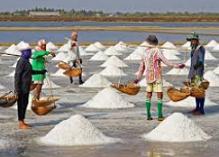Before entering fully into establishing the meaning of the term sodium chloride, it is necessary to know the etymological origin of the two main words that give it its shape:
-Chloride comes from Greek. Specifically, it is the result of the sum of two components of said language: "khloros", which means "light green", and the suffix "-uro", which is synonymous with "acid salt".
-Sodium, on the other hand, emanates from Latin. In its case, it derives from "sodium."
Sodium chloride , also known as sodium chloride , is table salt . It is a white, crystalline substance that is used to season food .
 The formula of this chemical compound is NaCl . It is formed by a chloride anion and a sodium cation and is classified as an ionic compound since it is composed of two substances that have an important difference in terms of their electronegativities.
The formula of this chemical compound is NaCl . It is formed by a chloride anion and a sodium cation and is classified as an ionic compound since it is composed of two substances that have an important difference in terms of their electronegativities.
It is possible to find sodium chloride in the crust of planet Earth and in the water of the oceans. For use, you can obtain salt from the rock called halite or through the evaporation of seawater. The world's largest producers are the United States , China , Germany and India .
The most common use of sodium chloride is linked to food . Most foods are seasoned by adding a certain amount of salt, which has a characteristic flavor. Excessive consumption of sodium chloride, however, is harmful to health because it causes an increase in blood pressure ( hypertension ).
Another food-related use of sodium chloride is for food preservation . Due to its osmotic power, it allows bacteria and viruses to be dehydrated. In this way, by applying sodium chloride on meat, it is protected from bacterial action.
In addition to everything stated above, we cannot ignore another series of singularities or curiosities about sodium chloride, such as the following:
-It is used at an industrial level. Specifically, it plays a fundamental role in textile industries and even in refineries.
-With regard to health, it should be noted that, in addition to the negative consequences mentioned regarding excessive salt consumption, there are others that are equally relevant. We are referring, specifically, to the fact that it can cause skin problems, that it can cause harmful damage to the respiratory tract, or that it can increase fluid retention. Not to mention that it can also increase the chances of suffering from dehydration or kidney disease.
-When cleaning, it is considered to be very useful to eliminate, for example, mold.
-Sodium chloride has a melting point of 801º while its density is 2.16 g/ml.
-Its molar mass is 58.44 g/mol.
Likewise, sodium chloride is used as an antiseptic to disinfect wounds and heal ulcers. Salt, on the other hand, is thrown on snow -covered roads as it lowers their freezing point and causes them to melt. This way the road can be freed and vehicles can circulate.
